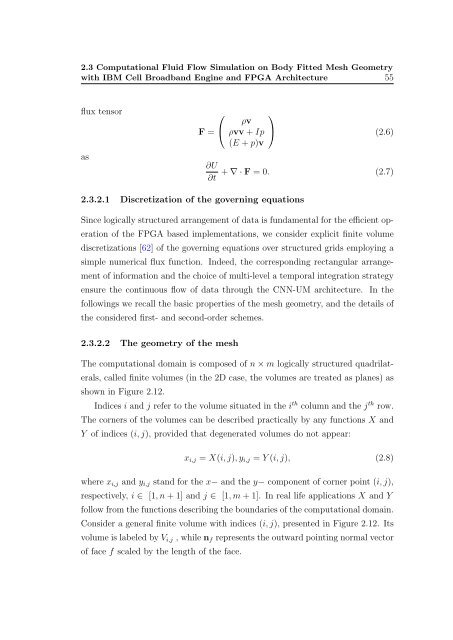PPKE ITK PhD and MPhil Thesis Classes
PPKE ITK PhD and MPhil Thesis Classes
PPKE ITK PhD and MPhil Thesis Classes
Create successful ePaper yourself
Turn your PDF publications into a flip-book with our unique Google optimized e-Paper software.
2.3 Computational Fluid Flow Simulation on Body Fitted Mesh Geometry<br />
with IBM Cell Broadb<strong>and</strong> Engine <strong>and</strong> FPGA Architecture 55<br />
flux tensor<br />
as<br />
⎛<br />
F = ⎝<br />
∂U<br />
∂t<br />
ρv<br />
ρvv + Ip<br />
(E + p)v<br />
⎞<br />
⎠ (2.6)<br />
+ ∇ · F = 0. (2.7)<br />
2.3.2.1 Discretization of the governing equations<br />
Since logically structured arrangement of data is fundamental for the efficient operation<br />
of the FPGA based implementations, we consider explicit finite volume<br />
discretizations [62] of the governing equations over structured grids employing a<br />
simple numerical flux function. Indeed, the corresponding rectangular arrangement<br />
of information <strong>and</strong> the choice of multi-level a temporal integration strategy<br />
ensure the continuous flow of data through the CNN-UM architecture. In the<br />
followings we recall the basic properties of the mesh geometry, <strong>and</strong> the details of<br />
the considered first- <strong>and</strong> second-order schemes.<br />
2.3.2.2 The geometry of the mesh<br />
The computational domain is composed of n × m logically structured quadrilaterals,<br />
called finite volumes (in the 2D case, the volumes are treated as planes) as<br />
shown in Figure 2.12.<br />
Indices i <strong>and</strong> j refer to the volume situated in the i th column <strong>and</strong> the j th row.<br />
The corners of the volumes can be described practically by any functions X <strong>and</strong><br />
Y of indices (i, j), provided that degenerated volumes do not appear:<br />
x i,j = X(i, j), y i,j = Y (i, j), (2.8)<br />
where x i,j <strong>and</strong> y i,j st<strong>and</strong> for the x− <strong>and</strong> the y− component of corner point (i, j),<br />
respectively, i ∈ [1, n + 1] <strong>and</strong> j ∈ [1, m + 1]. In real life applications X <strong>and</strong> Y<br />
follow from the functions describing the boundaries of the computational domain.<br />
Consider a general finite volume with indices (i, j), presented in Figure 2.12. Its<br />
volume is labeled by V i,j , while n f represents the outward pointing normal vector<br />
of face f scaled by the length of the face.






![optika tervezés [Kompatibilitási mód] - Ez itt...](https://img.yumpu.com/45881475/1/190x146/optika-tervezacs-kompatibilitasi-mad-ez-itt.jpg?quality=85)









